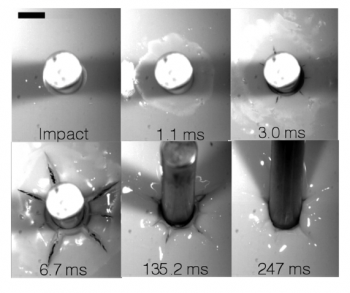How Cornstarch Could Lead To Better Protective Gear

A quick scan of Eric Brown’s laboratory finds all the requisite high-tech equipment and equation-filled whiteboards. More incongruous are the many containers of Argo cornstarch - the same kind that might be in your kitchen. Brown sees in it the potential to reduce concussions or save a police officer’s life.
The combination of water and cornstarch offers a fascinating, but not entirely understood phenomenon. Fill a pool with this liquid and then run on it. Keep running, and you might as well be on a hard floor. Stop running, though, and you sink right in.
 “Think about what it says about the material,” says Brown, Assistant Professor of Mechanical Engineering & Materials Science. “It’s very good about responding to impacts. If we can figure out the properties of this material, he said, we can figure out how to use it for making helmets, bulletproof vests and sports padding.
“Think about what it says about the material,” says Brown, Assistant Professor of Mechanical Engineering & Materials Science. “It’s very good about responding to impacts. If we can figure out the properties of this material, he said, we can figure out how to use it for making helmets, bulletproof vests and sports padding.
It’s related to a phenomenon known as shear thickening. Certain type of fluids will change properties dues to various stresses. But water-and-cornstarch solutions’ response to impact is unique, so Brown and his team have developed a special rheometer to measure these effects. A high-speed camera captures what happens when a rod is jammed into a container of the solution. One thing they noticed is that it actually causes cracking (see photo on the left).
“Fluids don’t crack, so that’s one of the things that tells us it’s behaving like a solid.”
But only for a few seconds; then it goes back to a fluid state. The potential for this is huge. Crack a bike helmet, and you have to get a new one. But what if it were made from material that heals itself? It could also make for a very flexible material.
“That’s also been a big issue for policemen and military,” Brown said. “Bulletproof vests do great at stopping bullets. But they’re so bulky and rigid that they’re hard to wear for someone running and doing all this physical activity.”
Brown says they’re about “halfway there,” to finding real uses for this quirky phenomenon.
“The thing we don’t understand still is, how does it transition into a solid?” he said. “We can tell that it does but don’t know exactly what’s happening at the microscopic level, so that’s something we’re still trying to understand. That’s one of the open research questions.“

